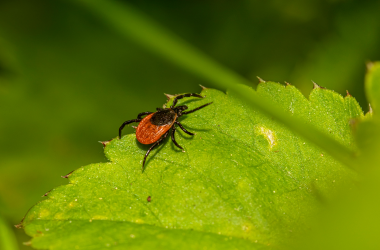Blog
Featured in Saratoga Family Spring/Summer 2023 Edition
BY MARISSA BROADLEY, MPH, MSED, RN, CPHQ, CPPS, LSSGB
Each spring, we're inundated with information on tick safety—and for good reason. They're most active in the warmer months, and can transmit diseases to animals and people. That's not to say you should cancel any plans, though. It's possible to enjoy the sunshine and the warm weather while also protecting your family from ticks.
- Create a tick-free zone in your yard. Mow your lawn frequently to keep the grass short. Place your patio furniture and playground equipment away from the edge of the yard and in sunny locations, if possible. Keep your yard free of garbage so ticks don't have extra places to hide.
- Dress appropriately. Long sleeves and long pants are best when you're outdoors or in backyards with tall grass. Tuck your shirt into your pants and your pant legs into
 your socks. Wear light colors because you'll be able to see any bugs crawling on you. At the end of the day, throw your clothes into the dryer on high heat for 20 minutes to kill any unseen hitchhikers.
your socks. Wear light colors because you'll be able to see any bugs crawling on you. At the end of the day, throw your clothes into the dryer on high heat for 20 minutes to kill any unseen hitchhikers. - Perform thorough checks at the end of the day. You can and should do cursory inspections by running your fingers through your hair and checking cuffs or folds in your clothing. Ticks like warm areas on the body, so once you're finished outside, check behind your knees, in your elbows and belly button, and under your armpits. Don't forget your groin and your scalp, too.
- Prevent ticks on your pets. Tick bites are often pretty hard to detect on your pets, especially because it can be days or weeks before symptoms appear. In the meantime, ticks could be in your home or lingering outside in heavily-trafficked areas, which is why it's very important to use a preventative product on your pet. Talk to your veterinarian about what might be best, and always include your pet in any end-of-day tick checks. Look specifically in and around the ears and eyelids, under the collar and the front legs, between the back legs and toes, and around the tail.
If you do find a tick, don't panic. The risk of tick-borne illness is greatly reduced if you remove it within 36 hours, and not all bites require antibiotics.
To safely remove a tick, you'll need a pair of pointed tweezers, or a tool specific to tick removal.
- Grasp the tick by the head right where it enters the skin.
- Pull firmly, steadily upwards.
- Place the tick in a small container of rubbing alcohol to kill it.
- Clean the wound with rubbing alcohol or hydrogen perioxide, and monitor it for 30 days.
If you develop a rash or flu-like symptoms, call your healthcare provider immediately. Additionally, if you find a tick or a suspected bite while your primary care office is closed, you can visit one of Saratoga Hospital's urgent care centers in Queensbury or Wilton, or Malta Med Emergent Care in Malta, which is open 24/7.

